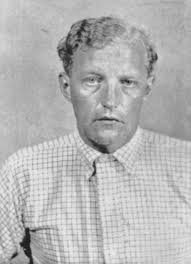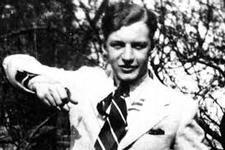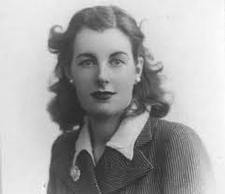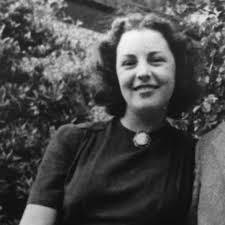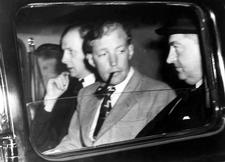The morning of Friday 21st June 1946 brought some welcome sun and warmth to London after what had been weeks of disappointing summer weather. In the Pembridge Court hotel in Notting Hill, a maid knocked on the door of room 4 and announced that she was doing her rounds of cleaning. Hearing no reply, she used the master key to let herself in and was greeted with a horrific sight. A woman lay naked on the bed, her ankles tied, slash marks and bruising all across her body, her nipples almost bitten off and with something inserted violently into her vagina. The maid checked for a pulse but it was clear the woman was dead, and she stumbled down to reception to report her awful discovery.
The woman was identified as Margery Gardner, and it was quickly ascertained that she had spent the previous night in the company of a man named Neville Heath. The handsome 29-year-old former RAF pilot had already left London for Surrey to see his fiancé, and was calm when police announced over the weekend that they were keen to speak to him. An accomplished liar who had used his charm to travel the world and cover up his violent nature and history of petty crimes, Heath weaved a tale of Gardner retiring to the room with a mystery man. Within a month his story would be dismissed as fiction and he would be destined for the gallows, but not before he was able to claim another unfortunate victim who had succumbed to his powerful charisma.
The making of a murderer
The early life of this notorious killer is best summed up by Greg Poulsen and Vanessa Richardson on their Serial Killers podcast. Neville George Clevely Heath was born on 6th June 1917 in Ilford, a town in Essex which has since been swallowed into the London suburbs. His parents, William and Bessie Heath, were prosperous members of middle-class with William earning a living as a barber. Neville was a strikingly beautiful baby, with golden hair and flashing blue eyes, and he was adored by his parents, who had a second son in 1920. Tragically, Neville’s younger brother died from tuberculosis in infancy, and this would have consequences in his future for two reasons: first, he was emotionally scarred by the death of his young brother and second, his parents naturally invested all of their love in their surviving son and overlooked his many childhood transgressions, including petty crimes such as shoplifting. This lack of discipline instilled a sense in young Neville that he could get away with anything.
In 1928, William and Bessie welcomed another son, whom they named Michael, and Neville was sent to Rutlish grammar school soon after. It was here that he was first exposed to physical punishment as a legitimate means of discipline – a far cry from his lack of punishment at home. He charmed his teachers and peers alike but was bothered by the fact that most of his classmates appeared to be from wealthier backgrounds than he was, and soon developed an obsession with attaining wealth and status that would stay with him for the rest of his life.
Neville had a history of petty crimes but as he grew older he began to show signs of a darker nature. Aged 15, he and some friends attended a party where he attempted to assault a female guest and was only stopped when the girl’s cries for help were heard by the other partygoers. Shocked at the interruption, Neville tried to explain himself but was dragged out of the room and kicked out of the party. The girl’s father angrily confronted him the next day, threatening to tell the school and the police, but Neville had regained his composure by then. He was sorry, he said, for what he had done but it had all been a misunderstanding triggered by a few too many beers. He had only intended to tease the girl, and he wasn’t the first teenager to embarrass himself because he’d had too much to drink. The girl’s father reluctantly agreed not to tell the school. Neville had escalated his misdeeds and still remained unpunished.
Neville Heath as a teenager
First taste of failure
When he failed his final school exams, it was the first time Neville Heath had not been able to fall back on his charm to get him out of a tough spot. He was forced to take a job at a textile factory in London but refused to give up on his dreams of climbing the social ladder. Observing the city around him, he noticed that a sure way to gain status, no matter what your background was, was to be in military uniform. Neville set himself the goal of joining the military, but he would not simply enlist in the army as a lowly private, or in the navy where he would be forced to spend long months away from the buzz of London. Instead, he would enlist in the Royal Air Force.
As far as Heath was concerned, being a pilot would be perfect. Air travel was still very young in the 1930s and the new RAF was considered the reserve of daring young men, so he was sure to be respected. But the best part for Heath was that he would not actually have to do much work after he completed his training. With the Second World War still a few years away, Heath could qualify as an army pilot and spend some time at RAF bases, but would be able to spend most of his time frequenting the elite parties that his uniform got him invited to.
Enlisting in 1935, he was fully qualified by 1936 but had to lie about his background to keep up with his new friends who relied on inherited wealth to fund their regular elite dinners and trips to the pub. Neville modified his accent and confidently said that he had been to Eton and Oxford, but was soon reduced to stealing to keep up appearances. Feeling there was a legal net closing in on him, he fled from his base in 1937 to hide with his family, who by now had moved to Wimbledon. He was quickly court martialled and dismissed from the RAF that September.
Escalating crimes and fraud
Heath briefly moved to Nottingham, where he impersonated a Lord and continued to live with money he did not have. He was caught when he tried to buy an expensive car but turned on the charm and convinced the court that he was merely a silly young man who had got in over his head. Let off lightly, he returned to London but by summer 1938 he finally found himself in a legal bind he could not escape. When police tracked some stolen jewellery to a pawn broker, the broker pointed to Neville Heath as the man who had sold it to him. In July, Heath was sentenced to three years in a prison for young persons.
Second World War
By the time he was released, the Second World War was well underway, and Heath saw his chance to get back into the RAF. However, his prior history and criminal record ensured he was swiftly rejected. He despondently enlisted in the army and was posted to the middle east, where he was disappointed at the lack of action but more than happy to join his peers in their extra-curricular activities in the brothels and bars near their base. Heath was astounded at the sexual services available in the brothels and developed a penchant for sexual sadism. So keen was he that he invented a story about a series of operations he needed to have so that he could spend more and more time away from his army duties. Suspicious, his superiors investigated him and found not only that he had been lying but that he had been using a second paybook (the means through which soldiers were paid) to fund his activities. Neville Heath received his second court martial and was put on a ship bound for England to answer for his crimes.
The ship was following the long route back to Europe, around the coast of Africa, and stopped in Durban, South Africa. Never one to miss an opportunity, Neville escaped from the ship and hid in a hotel until it left harbour. Now a free man and completely unknown in South Africa, he could be whoever he wanted to be. He started using the alias James Cadogan Armstrong, pretending to be a South African born, English raised aristocrat, and by the end of 1941 he had signed up for the South African air force. Heath’s confidence put any suspicions about his background to rest and he soon met Elizabeth Rivers, a 22-year-old from an immensely wealthy family. With her beauty and her family’s wealth, she was perfect for Heath, who used all his charm and charisma to win her over. The couple were wed within a year and soon welcomed a baby boy, Robert Michael Cadogan Armstrong. Now back to attending elite parties due to his marriage, Heath was content for a while, but his true identity was soon revealed. Amazingly, he managed to convince South African authorities that he was a changed man and that, since he had not committed any crimes during his time there, he should be allowed to remain in his post. He also managed to keep his young family, as Elizabeth decided she had fallen in love with the man whatever his name was and did not want to be left as a single mother.
Heath could have stopped here, reflecting that he was incredibly fortunate to have escaped this episode with his job and his family. But he had still not given up on returning to the RAF and was pleasantly surprised when a hopeful application he made under his old alias was accepted. After travelling back to Britain without his wife and son, he won respect for his heroics when he saved all of his crew as his plane was hit and spiralled to the ground, but his heavy drinking was quickly starting to erode his charming façade. He was dismissed from the force for a second time, and headed back to South Africa where he found his wife had filed for divorce. By the end of 1945, the divorce had been finalised and he was deported from South Africa due to mounting charges of fraud and stealing.
Murders in England
Divorced, jobless, drinking heavily, and living with his parents in Wimbledon, Heath set off on a path that would lead to three deaths – including his own. In February 1946, a young woman named Pauline Brees woke up in the Strand Palace Hotel in London to find herself bound and gagged, with a naked Neville Heath standing over her. She had met him the night before and been instantly seduced by the handsome former army pilot who gave no impressions that he was capable of inflicting such a vicious assault on her. She managed to scream for help before Heath knocked her unconscious, and luckily the screams were heard by hotel staff who burst in and apprehended her attacker. Heath was arrested but Brees did not push charges against him, and he was allowed to walk free.
32-year-old Margery Gardner was an artist and mother
Heath had yet again been able to push the boundaries and get away with it. His descent into a hard-drinking sexual sadist was not being halted by anyone – least of all himself. On Thursday 20th June, Neville met a friend in a pub in Knightsbridge and got talking to Margery Gardner, a 32-year-old artist and single mother who was recently separated from her husband. He whisked her to the exclusive Panama club nearby, and witnesses said the pair appeared very drunk when they left after midnight. In the early hours of the Friday morning, they arrived at the Pembridge Court Hotel in Notting Hill. Only one of them would leave the building alive.
In his later confession, Neville alleged that he blacked out from all the alcohol he had consumed and woke up to find Margery dead. There is no doubt the he was very drunk on the night in question and it is possible that he did not fully remember what he had done, but the injuries Gardner suffered – extensive bruising, 17 lacerations across her body and an object forcefully shoved and twisted in her vagina – were purposeful and sustained. They were not the actions of someone who was incapacitated by drink.
The next day, Heath left the hotel and caught a train to Worthing, in Sussex, to meet his fiancé. Ten years his junior, Yvonne Symonds had met him at a dance in Chelsea only a week previously and knew him only as ‘Jimmy Heath.’ The Gardner murder was front page news the following day, Saturday 22nd June, and, knowing that he would be a suspect, he prepared Symonds for his inevitable questioning by breathlessly telling her that he had been in the same hotel that the murder had taken place in. Sure enough, the police announced that they wanted to speak to him and he agreed that he ought to offer any help he could, writing to the lead detective on the case with a story about how he had spent the evening with Ms Gardner and given her the keys to his hotel room as she retired for the night with a man named ‘Jack’.
After writing the letter Heath travelled to Bournemouth, booking a room in the Tollard Royal Hotel under the name Rupert Brooke. It was in Bournemouth that on Wednesday 3rd July he met Doreen Marshall, a 21-year-old woman who had come to the seaside town to recover from flu. Won over by ‘Mr Brooke’s’ easy charm and dazzling smile, she agreed to have tea with him that afternoon and later joined him for dinner at his hotel. Just before midnight the couple were seen as they walked towards the Norfolk hotel, where Doreen was staying.
Lindsay Neal tells us that on Friday 5th July, the manager of the Norfolk hotel became concerned after he realised Doreen had not been seen since she went for dinner two nights previously. He contacted the manager of the Tollard Royal, where he knew Doreen had dined that night, who in turn got in touch with Heath to ask whether she had been his guest for dinner. Heath denied that it was Doreen Marshall he had dined with but agreed to go the police station to look at pictures of the missing girl and clear matters up. On the evening of Saturday, 6th July, he walked into the police station and introduced himself as Rupert Brookes. While there, an officer was struck by how much Mr Brookes looked like Neville Heath, the man whose image had been circulated by Scotland Yard for his connection to the Gardner murder.
Heath asked if he could have his jacket brought to the station and an officer was dispatched to collect it from the Tollard Royal. Searching the pockets of the jacket, the officer found a cloakroom ticket and had a hunch. He took the ticket to Bournemouth train station and offered it to the cloakroom attendant, who retrieved a suitcase that contained clothing labelled with the name ‘Heath’ and a few items stained with blood. Just before 10pm, Neville Heath admitted his real identity and he was whisked back to London to be charged with the murder of Margery Gardner. Police in Bournemouth came to the grim realisation that Doreen Marshall had likely suffered a similar fate to Gardner.
The following day, a woman was walking her dog just outside Bournemouth and noticed a large amount of flies gathering near a bush. She mentioned it to her father, whose suspicions were sufficiently aroused to investigate the matter. At 8 O’clock that Sunday evening, the daughter showed her father where she had seen the flies and they came across the body of Doreen Marshall, naked apart from one shoe, battered and cut with an object thrust into her vagina.
Trial and execution
Neville Heath was brought to trial at the Old Bailey in London in September 1946. Realising that he could not dispute the evidence against his client, the defence lawyer tried to argue that Heath was not guilty by reason of insanity. However, two doctors who had examined him in prison testified that while Neville was a psychopath, he was not insane and knew full well that his actions were wrong. The jury took just one hour to find him guilty, and he was sentenced to death.
On 16th October 1946, Neville Heath was led to the gallows. As was customary at the time, he was offered a glass of whiskey before the noose was placed around his neck. As told by Alex Winter, Heath took up the offer, adding ‘while you’re about it, sir, you’d better make it a double.’ He was hanged moments later, and so came to an end the life of that most dangerous of killers – a handsome, charming individual who gave no hint of the depravity he was capable of.
Acknowledgements
The Ministry of History is not an academic source. Our pieces are written by writers who have been studying history for years and are well versed in and influenced by countless other writers and works. For this article specifically our sources have included:
'Neville Heath', episode on Serial Killers podcast hosted by Greg Poulsen and Vanessa Richardson (2019)
'Neville Heath', post on Murderpedia.org
'Neville Heath: Murderer who brought horror to Bournemouth 70 years ago', article by Alex Winter, published by bournemouthecho.co.uk (2016)
'Filming the heart of a murderer', article published by Lindsay Neal, published in dorsetlife.co.uk (2016)
Images
Image one - prisonersofeternity.co.uk
Image two - gettyimages.com
Image three - facebook.com
Image four - pintrest.nz
Image five - gettyimages.com
